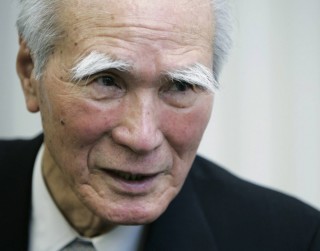Loading
Search
▼ Former PM Tomiichi Murayama Dies At Age 101
- Category:Other
Former Japan Socialist Party Prime Minister Tomiichi Murayama, who led a coalition government with longtime rival the Liberal Democratic Party in the mid-1990s and delivered a key statement apologizing for Japan’s World War II aggression, died Friday morning in the city of Oita. He was 101.
Born on March 3, 1924, in Oita Prefecture, Murayama moved to Tokyo in 1938 but was later drafted into the armed forces and was stationed in Kumamoto at the end of World War II. He won his first Lower House election in 1972.
In 1993, he became chairman of the Japan Socialist Party.
“Mr. Murayama bore the heavy responsibility of serving as prime minister, devoting himself to tackling numerous challenges. He championed 'people-centered politics,'" Prime Minister Shigeru Ishiba said in a statement Friday.
He noted Murayama’s leadership following the Great Hanshin Earthquake and the sarin gas attack in Tokyo by the Aum Shinrikyo doomsday cult, as well as his attempts to resolve the issue of Minamata disease, which involved large-scale mercury poisoning in the town of Minamata, Kumamoto Prefecture.
On June 29, 1994, Murayama became the 81st prime minister of Japan, leading a coalition government that also included the LDP and a smaller party called Sakigake.
Under Murayama, the coalition agreed to uphold the Japan-U.S. Security Treaty, recognize the constitutionality of the Self-Defense Forces and accept the use of the Hinomaru flag and “Kimigayo” anthem, all of which the Socialist Party had long opposed.
Murayama said that his Cabinet's role was to draw a line under the postwar period on the 50th anniversary of the end of World War II, leading to the issuance of the Murayama Statement on Aug. 15, 1995, his most notable legacy.
Born on March 3, 1924, in Oita Prefecture, Murayama moved to Tokyo in 1938 but was later drafted into the armed forces and was stationed in Kumamoto at the end of World War II. He won his first Lower House election in 1972.
In 1993, he became chairman of the Japan Socialist Party.
“Mr. Murayama bore the heavy responsibility of serving as prime minister, devoting himself to tackling numerous challenges. He championed 'people-centered politics,'" Prime Minister Shigeru Ishiba said in a statement Friday.
He noted Murayama’s leadership following the Great Hanshin Earthquake and the sarin gas attack in Tokyo by the Aum Shinrikyo doomsday cult, as well as his attempts to resolve the issue of Minamata disease, which involved large-scale mercury poisoning in the town of Minamata, Kumamoto Prefecture.
On June 29, 1994, Murayama became the 81st prime minister of Japan, leading a coalition government that also included the LDP and a smaller party called Sakigake.
Under Murayama, the coalition agreed to uphold the Japan-U.S. Security Treaty, recognize the constitutionality of the Self-Defense Forces and accept the use of the Hinomaru flag and “Kimigayo” anthem, all of which the Socialist Party had long opposed.
Murayama said that his Cabinet's role was to draw a line under the postwar period on the 50th anniversary of the end of World War II, leading to the issuance of the Murayama Statement on Aug. 15, 1995, his most notable legacy.
The statement declared that “Japan, following a mistaken national policy, advanced along the road to war, only to ensnare the Japanese people in a fateful crisis, and, through its colonial rule and aggression, caused tremendous damage and suffering to the people of many countries, particularly to those of Asian nations.”
The statement angered many Japanese conservatives and right-wingers, especially within the LDP. But no prime minister since Murayama has rejected the statement.
During a news conference on Oct. 10, Ishiba reflected on the causes of WWII, and said his Cabinet upholds the Murayama Statement as well as subsequent statements delivered in 2005 and 2015, on the 60th and 70th anniversaries of the war’s end.
During Murayama’s premiership, his government dealt with the Great Hanshin Earthquake in January 1995, which devastated Kobe and killed more than 6,400 people.
The response to the quake by his government was criticized as slow and his dispatch of the Self-Defense Forces to aid the victims generated controversy at the time. But eventually it led to legal changes that allowed the SDF to respond to later disasters, such as the Great East Japan Earthquake and tsunami that hit the Tohoku region on March 11, 2011.
In addition to the quake, Murayama also had to deal with the March 1995 sarin gas attack by the Aum Shinrikyo doomsday cult that targeted Tokyo’s subway system.
Murayama’s tenure lasted until he was replaced by Prime Minister Ryutaro Hashimoto of the LDP in 1996.
He retired from politics in 2000.
The statement angered many Japanese conservatives and right-wingers, especially within the LDP. But no prime minister since Murayama has rejected the statement.
During a news conference on Oct. 10, Ishiba reflected on the causes of WWII, and said his Cabinet upholds the Murayama Statement as well as subsequent statements delivered in 2005 and 2015, on the 60th and 70th anniversaries of the war’s end.
During Murayama’s premiership, his government dealt with the Great Hanshin Earthquake in January 1995, which devastated Kobe and killed more than 6,400 people.
The response to the quake by his government was criticized as slow and his dispatch of the Self-Defense Forces to aid the victims generated controversy at the time. But eventually it led to legal changes that allowed the SDF to respond to later disasters, such as the Great East Japan Earthquake and tsunami that hit the Tohoku region on March 11, 2011.
In addition to the quake, Murayama also had to deal with the March 1995 sarin gas attack by the Aum Shinrikyo doomsday cult that targeted Tokyo’s subway system.
Murayama’s tenure lasted until he was replaced by Prime Minister Ryutaro Hashimoto of the LDP in 1996.
He retired from politics in 2000.
- 17/10 18:19
- Comment (0)
- Trackback(0)



